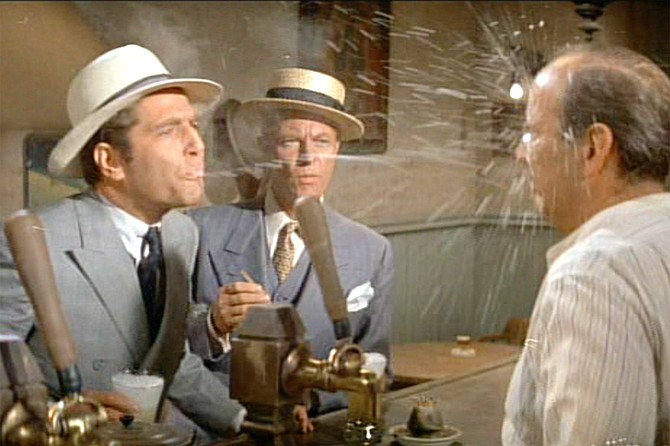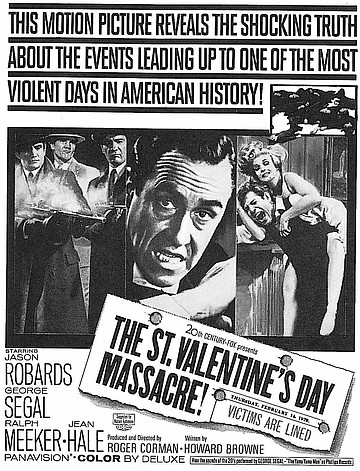 Facebook
Facebook
 X
X
 Instagram
Instagram
 TikTok
TikTok
 Youtube
Youtube

George Segal, a major luminary in my cinematic firmament, died last week, and with him went a galaxy of outstanding performances. Peter Gusenberg in The St. Valentine’s Day Massacre was to be my launching point, my first sighting of an actor whose lure, range, and mile-wide shmuck streak made for a welcome cinematic companion, one whose dependability spanned almost two decades. (I sorta lost track when he made a near-permanent transition to television, starting in the late ‘80s.) Doctor, soldier, spy, cop, inveterate gambler, junkie, lawyer, cowboy, or computer scientist, Segal played them all with style, reliability, and a touch of boyish charm. This streak of adolescent energy wasn’t reserved for light comedy, as evidenced by his performance as Gusenberg, Bugs Moran’s (Ralph Meeker) sadistic head gunman. It predates The Godfather with its depiction of the mob as a corporate entity, and contains some of the best ironic narration this side of Scorsese. It also marked Roger Corman’s entry into the big leagues. After years of making films on the cheap, this was to be the maverick filmmaker’s first assignment as a hired gun.
The four signature voices destined to boom eternally from high atop Hollywood’s Mt. Rushmore of sotto voce raconteurs are those belonging to Rod Serling, James Earl Jones, Orson Welles, and Paul Frees, the man Corman hired to narrate The St. Valentine’s Day Massacre. By sheer coincidence, Welles was considered for Al Capone, a role that later went to Jason Robards. (The heads of 20th Century Fox thumbs-downed the idea, fearing that Welles wasn’t the type who took to taking direction.) Frees’ exactingly written narration sets the scene: Hoover was president, Mickey Mouse made his debut, and flagpole sitting was the rage — six months before the stock market crash paved the way for the Great Depression. The sly sanctimoniousness in Frees’ delivery comes off as a less frantic, more reliable (if not laconic) variation on Walter Winchell’s voice-over contributions to The Untouchables.
Frees also acts as an aural timestamp, rattling off, in order of introduction, each major player’s date-of-birth, rap sheet and/or identifying traits (drinking heavily but never getting drunk, etc.). The voice-over also brings a touch of sobering reality by adding a character’s date and cause of death to the expository “to do” list. All traces of irony vanish when, on February 14, 1929, grim reaper Frees greets the day by introducing each of the seven victims with, “On the last morning of his life.”

Scenarist Howard Browne spent most of his career working in episodic TV. This was his second of three forays onto the big screen, all of which involved gangsters. It was also the first film devoted entirely to the massacre, which opens the picture, unfolding from the points-of-view of those passing by the Clark Street garage where Dan Cupid’s arrows became forever caught in the crossfire of tommy gun bullets. Corman stalwart Barboura Morris gets to throw out the first scream when she discovers the aftermath. She’s just one of the many regulars Corman brought with him through the Fox gate. Graduates of the Corman School include Jack Nicholson, Bruce Dern, Leo Gordon, Jonathan Haze, His Majesty Dick Miller, and Harold J. Stone, going full Chico Marx as Frank Nitti. How liberating an experience it must have been for director Corman, accustomed to working on cramped sets and even tighter budgets, to roam freely through the fully dressed Fox backlot. True to form, when presented with a $2.5 million budget (his largest to date), Corman brought the film in ahead of schedule and $200,000 in the black.
Robards gets top billing, but it feels like Segal has more screen time. Frees informs us that upon returning home from school to find his mother dead, 13-year-old Gusenberg proceeded to pry the wedding ring off her finger and deliver it to the nearest pawn shop. Gusenberg and brother Frank (David Canary) are the first gangsters to whom we’re afforded a formal introduction. In true Public Enemy fashion, the boys strongarm a Capone-stocked saloon keeper into changing their house brew in for a few kegs of Bugs’ suds.
Segal’s most memorable scene is also one of the film’s more brutal confrontations. While trying to retrieve his mink-on-a-string from a reluctant moll played by Jean Hale, the two engage in a dustup that makes Cagney’s grapefruit-to-the-face look like a polite serving. The fight resulted in a bruised back for Hale and a knee to Segal’s groin that managed to connect.
Segal’s bad guy wore a white hat, and with many more nefarious shnooks ahead, unless one escaped me, Peter Gusenberg was to be the actor’s only full-blown psychopath. He was too nice of a guy to spend a career playing heavys, particularly ones who didn’t allow room to showcase his lighter side. For every memorable dramatic role (Ship of Fools, Who’s Afraid of Virginia Woolf?, Biff in the 1966 made-for-TV version of Death of a Salesman) there were a dozen comedies. Segal enriched our lives with laughter and characters that displayed a side of humanity common to all of us, but in a manner unfamiliar.


George Segal, a major luminary in my cinematic firmament, died last week, and with him went a galaxy of outstanding performances. Peter Gusenberg in The St. Valentine’s Day Massacre was to be my launching point, my first sighting of an actor whose lure, range, and mile-wide shmuck streak made for a welcome cinematic companion, one whose dependability spanned almost two decades. (I sorta lost track when he made a near-permanent transition to television, starting in the late ‘80s.) Doctor, soldier, spy, cop, inveterate gambler, junkie, lawyer, cowboy, or computer scientist, Segal played them all with style, reliability, and a touch of boyish charm. This streak of adolescent energy wasn’t reserved for light comedy, as evidenced by his performance as Gusenberg, Bugs Moran’s (Ralph Meeker) sadistic head gunman. It predates The Godfather with its depiction of the mob as a corporate entity, and contains some of the best ironic narration this side of Scorsese. It also marked Roger Corman’s entry into the big leagues. After years of making films on the cheap, this was to be the maverick filmmaker’s first assignment as a hired gun.
The four signature voices destined to boom eternally from high atop Hollywood’s Mt. Rushmore of sotto voce raconteurs are those belonging to Rod Serling, James Earl Jones, Orson Welles, and Paul Frees, the man Corman hired to narrate The St. Valentine’s Day Massacre. By sheer coincidence, Welles was considered for Al Capone, a role that later went to Jason Robards. (The heads of 20th Century Fox thumbs-downed the idea, fearing that Welles wasn’t the type who took to taking direction.) Frees’ exactingly written narration sets the scene: Hoover was president, Mickey Mouse made his debut, and flagpole sitting was the rage — six months before the stock market crash paved the way for the Great Depression. The sly sanctimoniousness in Frees’ delivery comes off as a less frantic, more reliable (if not laconic) variation on Walter Winchell’s voice-over contributions to The Untouchables.
Frees also acts as an aural timestamp, rattling off, in order of introduction, each major player’s date-of-birth, rap sheet and/or identifying traits (drinking heavily but never getting drunk, etc.). The voice-over also brings a touch of sobering reality by adding a character’s date and cause of death to the expository “to do” list. All traces of irony vanish when, on February 14, 1929, grim reaper Frees greets the day by introducing each of the seven victims with, “On the last morning of his life.”

Scenarist Howard Browne spent most of his career working in episodic TV. This was his second of three forays onto the big screen, all of which involved gangsters. It was also the first film devoted entirely to the massacre, which opens the picture, unfolding from the points-of-view of those passing by the Clark Street garage where Dan Cupid’s arrows became forever caught in the crossfire of tommy gun bullets. Corman stalwart Barboura Morris gets to throw out the first scream when she discovers the aftermath. She’s just one of the many regulars Corman brought with him through the Fox gate. Graduates of the Corman School include Jack Nicholson, Bruce Dern, Leo Gordon, Jonathan Haze, His Majesty Dick Miller, and Harold J. Stone, going full Chico Marx as Frank Nitti. How liberating an experience it must have been for director Corman, accustomed to working on cramped sets and even tighter budgets, to roam freely through the fully dressed Fox backlot. True to form, when presented with a $2.5 million budget (his largest to date), Corman brought the film in ahead of schedule and $200,000 in the black.
Robards gets top billing, but it feels like Segal has more screen time. Frees informs us that upon returning home from school to find his mother dead, 13-year-old Gusenberg proceeded to pry the wedding ring off her finger and deliver it to the nearest pawn shop. Gusenberg and brother Frank (David Canary) are the first gangsters to whom we’re afforded a formal introduction. In true Public Enemy fashion, the boys strongarm a Capone-stocked saloon keeper into changing their house brew in for a few kegs of Bugs’ suds.
Segal’s most memorable scene is also one of the film’s more brutal confrontations. While trying to retrieve his mink-on-a-string from a reluctant moll played by Jean Hale, the two engage in a dustup that makes Cagney’s grapefruit-to-the-face look like a polite serving. The fight resulted in a bruised back for Hale and a knee to Segal’s groin that managed to connect.
Segal’s bad guy wore a white hat, and with many more nefarious shnooks ahead, unless one escaped me, Peter Gusenberg was to be the actor’s only full-blown psychopath. He was too nice of a guy to spend a career playing heavys, particularly ones who didn’t allow room to showcase his lighter side. For every memorable dramatic role (Ship of Fools, Who’s Afraid of Virginia Woolf?, Biff in the 1966 made-for-TV version of Death of a Salesman) there were a dozen comedies. Segal enriched our lives with laughter and characters that displayed a side of humanity common to all of us, but in a manner unfamiliar.
Comments